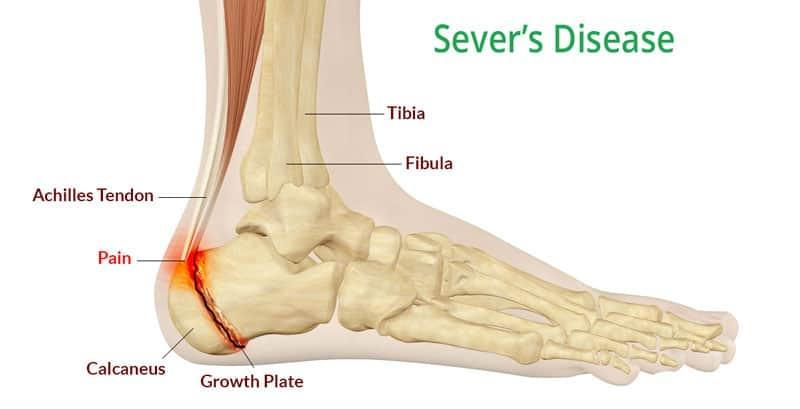What is Sever's Disease?
posted: Jan. 25, 2022.

WHAT IS SEVER'S DISEASE
Sever's disease is a swelling and irritation of the growth plate in the calcaneus (heel). The apophysis (growth plate) is a layer of cartilage near the end of a bone where most of the bone's growth happens. It is weaker and more at risk for injury than the rest of the bone. It is one of the most common causes of heel pain in growing children and adolescents. It is similar in theory and mechanism to another common childhood repetitive injury elsewhere on the lower extremity, Osgood-Schlatter disease (which affects the tibial tuberosity located below the knee joint).
WHY DOES IT OCCUR
Sever’s disease is caused by repetitive stress to the heel. It most often occurs during growth spurts, when bones, muscles, tendons, and other structures are changing rapidly. When a child is fully grown, the growth plates close and are replaced by solid bone. Until this occurs, the growth plates are weaker than the nearby tendons and ligaments and are vulnerable to trauma. Children and adolescents who participate in athletics are at an increased risk for this condition. However, less active adolescents may also experience this problem, especially if they wear very flat shoes.
The area of the calcaneal growth plate serves as the attachment point for the Achilles tendon—the strong band of tissue that connects the calf muscles at the back of the leg to the heel bone.
Repetitive stress from running, jumping, and other high-impact activities can cause pain and inflammation in this growth area of the heel. Additional stress from the pulling of the Achilles tendon at its attachment point can sometimes further irritate the area.
WHO IS AT RISK
Sever’s disease most often affects children during adolescent growth spurts. In girls, growth spurts typically occur between the ages of 8-13. Boys typically have growth spurts when they’re between ages 10-15.
Sever’s disease is rare in older teens. By late adolescence, a child’s growth plates have hardened into solid bone, and their muscles and tendons have lengthened to match the growth of their bones. Once the growth plate has closed, it is no longer susceptible to irritation and this condition.
Certain activities may be related to your child developing Sever’s disease:
sports that involve running and jumping on hard surfaces (track, basketball, gymnastics, soccer)
overtraining
shoes that don’t support your child’s feet
SYMPTOMS
- Heel pain, more so on the side(s) of the heel than on the bottom
- Mild swelling at the heel
- Pain during exercise
TREATMENT
Calf stretching exercises - when the Achilles and calf muscles are too tight, it creates extra tension on the back of the heel where the growth plate is located, so we want to focus on stretching the tendon to make it less stiff and thus create less tension.
Night splint - this goes along with the calf stretching exercises. While it is important to stretch during the day, many of us sleep in a more plantarflexed position for our feet, which ultimately contracts the Achilles tendon other than stretching it. A night splint is a brace that helps hold your foot at a 90-degree angle so that you are stretching the tendon throughout the night as well.
Icing - ice helps decrease swelling. We recommend applying ice to the area of pain/swelling typically for 20 min on and then 20 min off, and repeat several times a day. Make sure the ice pack is not too cold where it could irritate the child's skin, and if so then cover the ice pack in a towel to create a barrier between ice and skin.
NSAIDs - since this condition is ultimately a symptom of inflammation, anti-inflammatory medications are helpful in reducing inflammation and thus indirectly one's pain.
Gel heel cups - this will help reduce pressure on the heel when it contacts the ground (especially if the child wears less supportive/cushioned shoewear) and also helps elevate the heel, which shortens the Achilles tendon and thus less tension.
Orthotics - these provide support to the foot structure during the child's gait. They control mechanics and eliminate excess motion at the heel as well as provide arch support.
Physical therapy - therapists can help with stretching, strengthening, home exercise regimens, gait training, soft tissue massage, ultrasound, and other modalities.
Rest and/or CAM ("walker" boot) - most often, we are able to improve or resolve the symptoms with several of the treatment options listed above, but if the pain persists despite treatment, it is sometimes necessary to have the child decrease their activity/sports or wear a CAM (controlled ankle movement) boot for several weeks in order to immobilize the Achilles tendon and take pressure off the heel.
OTHER CAUSES OF HEEL PAIN
Plantar fasciitis - this is another very common cause of heel pain in both children and adults. It is caused by inflammation of the plantar fascia which is a band of tissue that runs from the bottom of the heel to the forefoot. Pain with this condition is usually located more on the bottom of the heel compared to Severs which is on the side of the heel bone. Your physician will be able to differentiate between the two during their clinical exam, though it is possible to have both conditions affecting the child at once. The good news is that treatment for Severs and plantar fasciitis is very similar and looks to accomplish the same goals of calf stretching, heel padding, arch support, and decreasing inflammation.
OUTCOME/RECURRENCE
Every patient is unique and there are no guarantees as to the outcome, but the majority of patients are able to improve their symptoms in several weeks-months and remain in sports throughout treatment. While the growth plate remains open, there is always a chance for recurrence. To decreased chances of recurrence, it is important to continue calf stretching and wearing supportive shoewear/cleats even once symptoms reside.
